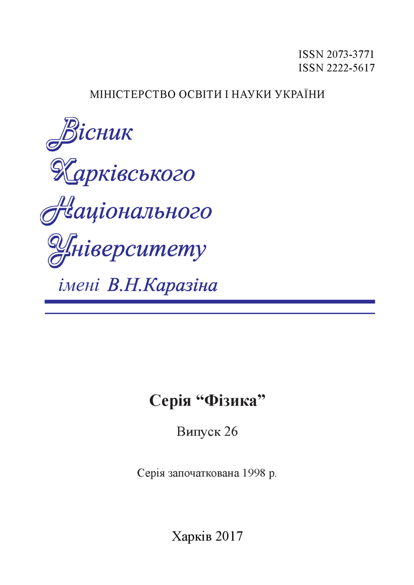Multi-fractal analysis of the gravitational waves
Анотація
У відповідності до нелінійної парадигми, сформульованої одним з авторів цієї статті наприкінці 1980-х років, всі процеси у відкритих, нелінійних, динамічних системах є дуже складними, нелінійними, надширокосмуговими або фрактальними.
Оскільки короткочасний сигнал гравітаційної хвилі, що був створений системою чорних дір, які перетворилися на одну чорну діру, та зареєстрований 14 вересня 2015 р. о 09:50:45 UTC двома детекторами LIGO, розташованими у Хенфорді та Лівінгстоні, має сильно нелінійну природу, наявність фрактальних і мультифрактальних властивостей його часової структури видається цілком можливим. Щоб дослідити ці властивості, застосовуються декілька сучасних методів монофрактального та мультифрактального аналізів.
Встановлено, що короткочасні сигнали гравітаційних хвиль, прийняті у Хенфорді та Лівінгстоні, є мультифрактальними. Будучи унікальними природніми надширокосмуговими процесами зі змінною середньою частотою, вони мають складну, нестаціонарну мультифрактальну структуру. Оцінюється набір відповідних числових параметрів цих сигналів, обговорюються отримані результати.
Завантаження
Посилання
A. Einstein. Sitzungsber. K. Preuss. Akad. Wiss., 1, 688 (1916).
A. Einstein. Sitzungsber. K. Preuss. Akad. Wiss., 1, 154 (1918).
K. Schwarzschild. Sitzungsber. K. Preuss. Akad. Wiss., 1, 189 (1916).
L. F. Chernogor, O. V. Lazorenko. Proc. 8th UWBUSIS, Ukraine, Odesa (2016), p. 47.
L. F. Chernogor. On the Nonlinearity In Nature and Science, V. N. Karazin Kharkiv National University, Kharkiv (2008), 528 p. (In Russian).
B. B. Mandelbrot. The Fractal Geometry of Nature, CA-Freeman, San Francisco (1982), 468 p.
K. J. Falconer. Fractal Geometry. Mathematical Foundations and Applications, Wiley & Sons, Chichester (1990), 288 p.
J. Feder. Fractals, Plenum Press, New York (1988), 305 p.
Wavelets and Fractals in Earth System Sciences, ed. by E. Chandrasekhar, V. P. Dimri, V. M. Gadre, CRC Press, Boca Raton (2014), 294 p.
D. P. Feldman. Chaos and Fractals. An Elementary Introduction, University Press, Oxford (2012), 431 p.
B. B. Mandelbrot. Fractals and Chaos: The Mandelbrot Set and Beyond, Springer (2005), 400 p.
А. A. Potapov. Fractals in Radio Physics and Radar, University Book, Moscow (2005), 848 p. (In Russian).
R. M. Crownover. Introduction to Fractals and Chaos, Jones and Barlett Publishers, Boston (1995), 300 p.
B. B. Mandelbrot. Multifractals and 1/f Noise, Springer (1999), 431 p.
D. Harte. Multifractals. Theory and Applications, Chapman and Hall/CRC Press, Boca Raton (2001), 246 p.
A. I. Chulichkov. Mathematical Models of the Non-Linear Dynamics, FIZMATLIT, Moscow (2003), 296 p. (In Russian).
M. Schroeder. Fractals, Chaos, Power Laws. Minutes from Infinite Paradise, W. H. Freeman and Company, New York (1991), 528 p.
F. C. Moon. Chaotic Vibrations. An Introduction for Applied Scientists and Engineers, Wiley and Sons, New York (2004), 310 p.
H. E. Hurst. Trans. Amer. Soc. Civ. Eng., 116 (1951), 770.
S. Mallat. A Wavelet Tour of Signal Processing, Academic Press, San Diego (1998), 577 p.
M. S. Taqqu. Self-similar Processes. Encyclopedia of Statistical Sciences, Wiley, New York (1988), v.8, p. 352.
J. W. Kantelhardt, S. A. Zschiegner, E. Konscienly-Bunde, S. Havlin, A. Bunde, and H. E. Stanley. Phys. A, 316, 87 (2002).
A. A. Lyubushin. Multivariate Time Series Analysis: A Practical Course, MGRI-RGGRU, Moscow (2010), 113 p. (In Russian).
V. V. Yanovskiy. Universitates, 3 (2003) (In Russian).
www.project.inria.fr/fraclab/.р








3.gif)
